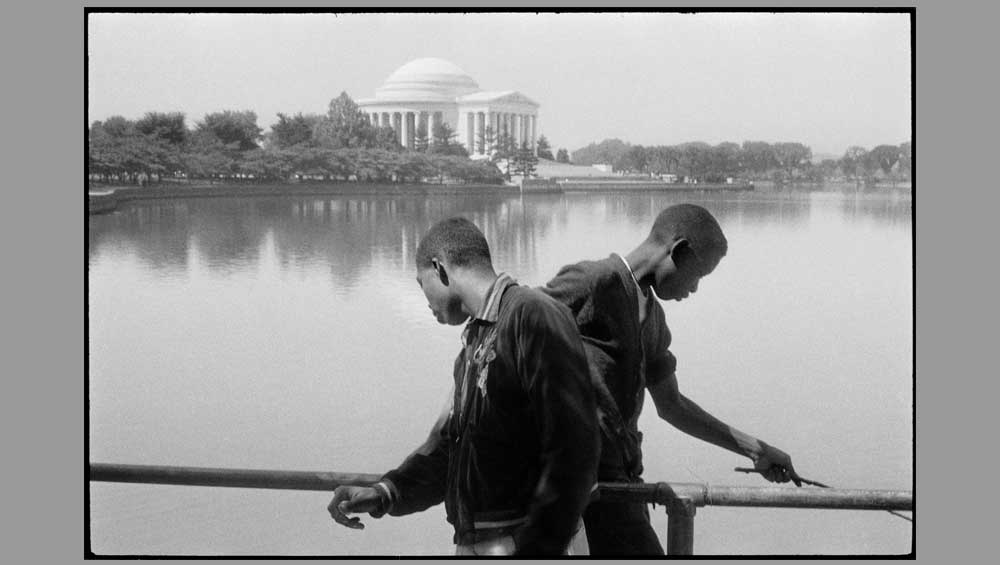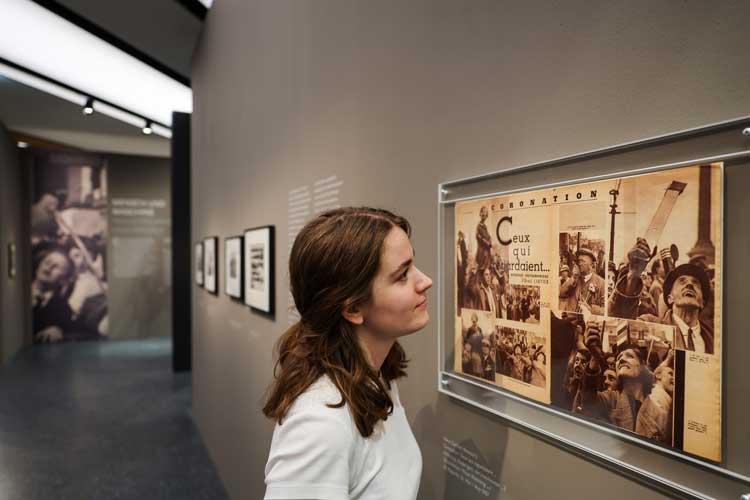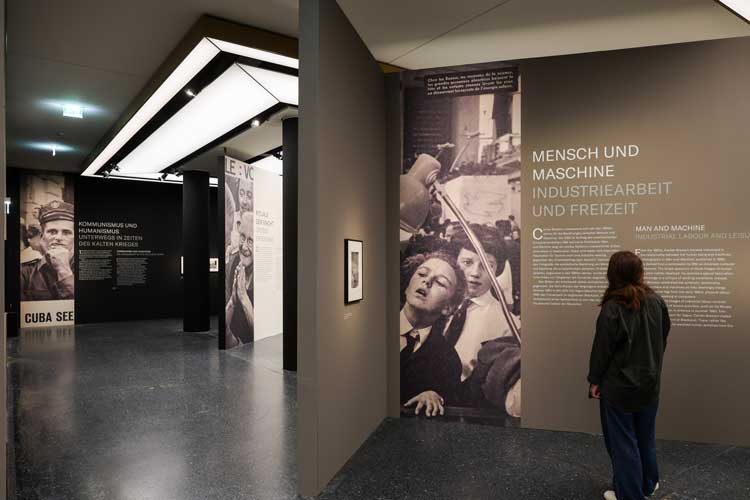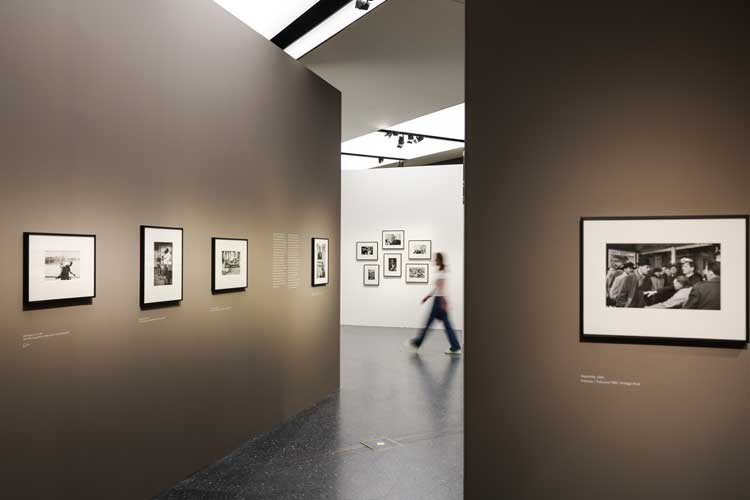
Henri Cartier-Bresson. Washington, USA, 1957. © 2024 Fondation Henri Cartier-Bresson / Magnum Photos.
Bucerius Kunst Forum, Hamburg
15 June – 22 September 2024
by SABINE SCHERECK
The French photographer Henri Cartier-Bresson (1908-2004) is probably the most referenced street photographer. He was a founding member of the photo agency Magnum Photos, created in New York in 1947, and one of the most prolific photojournalists of the 20th century. So, what prompted the Bucerius Kunst Forum in Hamburg to present a retrospective of someone who has such a prominent position in the history of photography and is anything but forgotten? Ulrich Pohlmann, who curated the exhibition with Kathrin Baumstark, says the last large retrospective in Germany was 20 years ago. To me, this is not a particularly convincing argument, but walking through Watch! Watch! Watch! Henri Cartier-Bresson, with its 240 black-and-white photographs spanning the 1930s to the 1970s and the various magazines that published his works, it is clear that there is indeed a lot to see – overwhelmingly so. The strength of this comprehensive exhibition is that it brings into view myriad facets of his oeuvre that are perhaps lesser known. Its weakness, however, is the way it presents his work.
But let us marvel first at the show’s achievement. The areas explored when entering the exhibition follow a certain chronology. Cartier-Bresson, who was born in a small town near Paris, took up photography at the age of 22. A visit to Ivory Coast in Africa in 1931 resulted in his first reportage and a Leica camera became his constant companion. This small-format camera was still relatively new to the market and enabled photographers to take shots quickly and discreetly outside the studio.

Henri Cartier-Bresson. Behind the Gare Saint- Lazare, 1932. © 2024 Fondation Henri Cartier- Bresson / Magnum Photos.
Among the first images lined up are some of his best known, taken in and around Paris, such as Behind the Gare Saint-Lazare, Place de l’Europe (1932), which shows a man leaping over a flooded area of town, and Sunday on the Banks of the Seine (1938), depicting workers sharing a picnic. One asset of this show is that the wall texts provide a valuable insight into the images rather than simply leaving the visitor to admire Cartier-Bresson’s skill at capturing poignant moments. The picnic, for example, was not merely about some fun in the sun: it was part of an assignment to document leisure activities that were appreciated in a new way after the recently elected government had implemented a 40-hour week and paid holidays. This gives a clue to the route this exhibition is taking, according to Pohlmann, which is to bring out Cartier-Bresson’s political side. He is often described as a humanist photographer and it is no surprise to read about his leftist leanings. In preparation for this exhibition, the curator viewed about 10,000 photographs in the Cartier-Bresson archive in Paris before settling on the 240 on display here. Yes, a political side does shine through, but as a photojournalist Cartier-Bresson simply chronicled a century in which immense political upheaval shaped societies around the world. So, the show is not exclusively political, unless the visitor is inclined to scrutinise every image for a political statement. After all, as a humanist photographer, it is the people Cartier-Bresson cared about when reaching for his camera.

Henri Cartier-Bresson. Coronation of King George VI, London, Great Britain, 12 May 1937. © 2024 Fondation Henri Cartier- Bresson / Magnum Photos.
Before world events took a dramatic turn with the second world war, an important assignment for Cartier-Bresson was the coronation of King George VI in London in 1937. Unlike his fellow press photographers, he did not strive to catch a glimpse of the king or the royal ceremony, but instead directed his view towards the public in Trafalgar Square who were waiting to witness this historic event. They are striking images: one of an elderly lady lifted on to the shoulders of two men to get a better view, another of a group of four women huddled together on a pavement littered with paper, each munching a small snack. Equally arresting is one of a large crowd rising behind a man asleep on a blanket of discarded newspapers. They all convey a sense of mayhem. They show how much the world has changed since that 1937 coronation and that of King Charles III last year, particularly as they tell of the vital role press photography played then. Television was in its infancy and broadcasts were limited to London, reaching only a very few people who had TV sets. This made the images photographers caught, which were distributed in millions through newspapers and magazines, the only way those miles away from the event could get a sense of what was happening.

Watch! Watch! Watch! Henri Cartier-Bresson, exhibition view. Photo: Ulrich Perrey.
Cartier-Bresson’s impressions of the coronation are followed by series of images documenting the resistance in France during the second world war, the liberation of Paris in 1944 and a displaced persons camp in Dessau, Germany, in 1945. From there, the trail moves beyond Europe, to India and China. In January 1948, Cartier-Bresson photographed the civil rights campaigner Mahatma Gandhi at his home in New Delhi only to find himself, a few days later, documenting Ghandi’s funeral after his assassination. Before long, the reporter found himself in a temporary city of tents near Delhi, to photograph 300,000 Hindu refugees from Pakistan, who had lost their homes in the wake of South Asia’s partition into India and Pakistan.
By the end of 1948, Life magazine asked him to travel further east, to China, to witness more political turmoil. The civil war there saw communist forces gain more power and the Chinese state dissolving. In the streets of Beijing, he observed everyday life: a street merchant, described here as a hawker, sitting on the floor with his goods spread out in front of him and what seems like a book shop behind him. A cigarette in hand, his look at the viewer is unmoved. Another picture shows an orderly crowd assembled behind a barely visible line on the ground with a single military man standing in front of them. It is titled Final Days of the Kuomintang (1948). The Kuomintang was the nationalist party of China, which retreated to Taiwan when the communists took over Beijing in 1949 and proclaimed the People’s Republic of China. Cartier-Bresson left Beijing before the arrival of the communists and headed to Shanghai. An intriguing picture was taken in Nanking: Chinese men in western suits and coats and wearing a strange array of hats, among them a tropical one or one that could pass as a lampshade. One man carries a tennis racket. What is the story behind this image? Sadly, no answer is given. A decade later, Cartier-Bresson revisited China to portray how the new political structures had profoundly changed the society, including the education of children and women’s crucial role in the workforce.

Watch! Watch! Watch! Henri Cartier-Bresson, exhibition view. Photo: Ulrich Perrey.
From there on, the exhibition begins to lose track. Following the wall along the perimeter of the space, the narrative on life in communist countries is inexplicably interrupted by a series on the theme of work, which could prompt the visitor to take a wrong turn seeking a continuation of that. The portrayal of communist countries is resumed along that wall through Cartier-Bresson’s visit to Moscow in 1954. He was the first western photographer to enter the Soviet Union after the second world war, and for this reportage he received a record sum of US$40,000 from Life. His pictures were reprinted by leading magazines in France, Germany and Italy. The memorable ones, however, originate from his return to the country in 1972. Among them is a humorous one called simply Sunday Morning, capturing two Russian men, each using one hand to push a perambulator through a snow-covered street while holding in the other hand a newspaper to which their eyes are fixed. It is quite an unconventional sight seeing two men taking up child-caring responsibilities at this period, yet their lack of commitment to the task is obvious. They do not even engage with one another, their newspapers taking up all their attention. It is a telling picture for a country that aimed to be progressive in not confining women to domestic duties, but where news had a different status than in the west. The press was state controlled in the Soviet Union and one wonders if the papers the men are devouring might have been smuggled into the country from the west and present a different perspective on the world than they are led to believe by their own press.
The way communist politics played out in Germany, to be precise in Berlin, is illustrated with Cartier-Bresson’s famous images of the Berlin Wall in 1962 – taken from the western side. One captures three men squeezing on top of a box to see what is happening in the street on the other side. Across the Atlantic, in the sunny Caribbean where Latin American rhythms fill the air, another society was held by the tight grip of communism: Cuba. After a visit in 1963, Cartier-Bresson returned to New York with pictures of what he saw on the streets: the military and political propaganda of the country’s leader, Fidel Castro.
At this stage, the exhibition unravels even further and loses focus. The visitor is inclined to drift to the numerous walls inside the exhibition space that display a patchwork of disparate themes. The walls are often arranged at an angle, leaving the visitor unsure where to turn to next. The presentation of the works develops into a rollercoaster ride through time and space. One series, arranged not by location but by theme across different locations, is the one mentioned earlier illustrating work. It brings together images as diverse as the Kennedy Space Center in 1962, where men in white shirts and black ties emerge from between endless rows of what look like early computers, and a textile factory in Manchester, photographed in the same year, still retaining the air of a factory a century earlier with its quaintly shaped iron machines. Creating an equally strong juxtaposition is an image taken in an office of a bank in New York in 1960, where a woman is poring over metre-long sheets of paper flowing on to the floor, with a moment caught in a factory in Bremen in 1960. Furnished with wooden workshop tables, it also looks as if it could be 100 years old. Poignantly, one man is using a table as a bed while taking a nap during a lunch break.

Watch! Watch! Watch! Henri Cartier-Bresson, exhibition view. Photo: Ulrich Perrey.
There is also a collection of leisure scenes from Blackpool, Naples, Miami and Los Angeles. It makes a good counterpoint to the ones about work, but the two series do not reference each other as in the maze of the walls they are not within each other’s sightline. Instead, having strolled around a few further corners, the visitor is confronted with pictures documenting the civil rights movement in Alabama. Other areas show impressions of Mexico, Japan, Spain and Italy. It is not clear what logic was followed in this arrangement. Colour coding might have been helpful to provide at least some guidance, when some themes span across several walls.
Towards the end, one wonders how much time Cartier-Bresson must have spent on planes and trains to travel the world to such a degree. Of course, being a photojournalist comes with an inherent mission to document crucial moments in history, but as the exhibition shows, there is more to him. It is not only about the big moments that made history in the 20th century, but for him it was about what everyday life looked like for people in different corners of the world – with all its joys, tragedies and quirks.
Cartier-Bresson died in 2004, but the exhibition ends in the 1970s, when he began distancing himself from Magnum Photos. Despite its flaws, the exhibition, like a love letter, pays tribute to a truly remarkable man, his outstanding legacy and his service to mankind in capturing its actions throughout the decades.